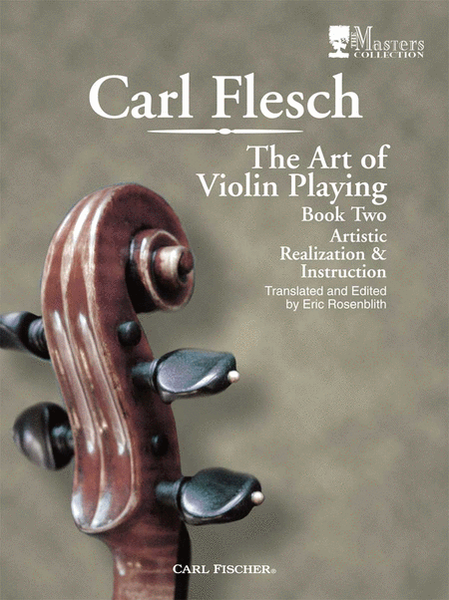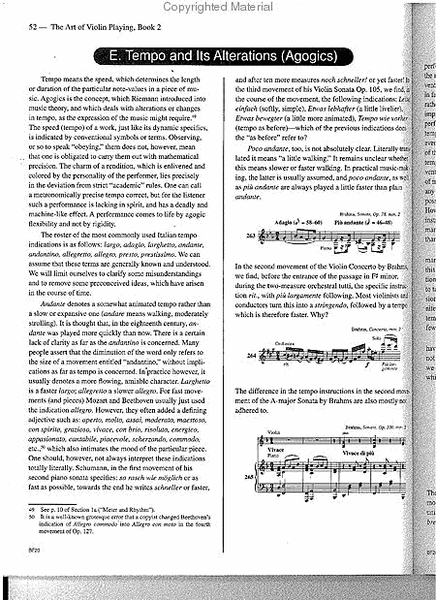The Art of Violin Playing
Book Two: Artistic Realization and Instruction; Second Edition
-
Ships in 1 to 2 weeks
Details
Description
SKU: CF.BF20
Book Two: Artistic Realization and Instruction; Second Edition. Composed by Carl Flesch. Edited by Eric Rosenblith. Perfect Bind - Å’ Hinge. Back To School. Softcover. With Standard notation. 208 pages. Carl Fischer Music #BF20. Published by Carl Fischer Music (CF.BF20).UPC: 798408065904. 9 X 12 inches.
This monumental, epoch-making work by Carl Flesch is themost comprehensive and thorough treatise dealing withpractically everything that is of concern to the violinist musician.This new translation makes the work more accessibleutilizing a contemporary idiom and having received ageneral updating. Newly engraved and freshly typeset,Flesch’s magnum opus remains the most significant andtrailblazing work ever written for violinists.
This monumental, epoch-making work by CarlFlesch is, in the opinion of many, certainly still themost comprehensive and thorough treatise dealing withpractically everything that is of concern to the violinistmusician.The basic thoughts contained in it have lostnone of their validity. It therefore seemed imperativeto further increase their relevance for English-speakingmusicians. In order to accomplish that goal, this newtranslation aims at making this work more accessibleby using a more contemporary idiom and by a generalupdating. While carrying out this task, it became clearthat in the course of time the general frame of referenceand overall cultural environment have indeed undergonesignificant changes since the original Germanpublication. For example, the reader will find that almostall references mentioning violinists appear in themasculine gender, despite the fact that a vast number ofhis own students and colleagues were women. Use ofthe masculine gender in this way was obviously just aconvention.In keeping with Carl Flesch’s original clear intentof producing a practical, though also philosophical,book, I decided to omit certain sections because,however interesting they might be as a document oftheir time, they would not be central to the basic thrustof the work. (For readers who are especially fascinatedby these “historic” elements, going back to the originalGerman version is recommended.) For me, the editor,readability and accessibility to English speakers aswell as violinists for whom English is a second languagewas of paramount importance, so even thoughI attempted to preserve some of Flesch’s flavorful witand descriptive language, I tried to avoid any distractionfrom the presentation of the core of his pedagogic,artistic and philosophical thoughts. The greatest valueof this book lies after all in fostering the practical applicationof these principles and insights. I also triedto follow Carl Flesch’s wish, expressed in one of hisletters regarding an earlier English version, not to attempta “word-by-word” translation. I therefore tookthe liberty frequently to put things in my own words,while scrupulously endeavoring to render precisely hismeanings and thoughts.Some additional remarks in connection with Book II areof great importance. This book contains so many profoundthoughts about artistry, aesthetics and humanity in generalthat it is easily seen to be of great significance to all musicians,not only string players. This book helps us better tounderstand the many facets of our art and points the way towardsachieving professionalism, musicianship and artistry.Flesch’s awareness of the importance of the “flow of history”and the evolution of musical taste and style is extremelyinsightful. It is quite obvious that we, as human beings,need to be very aware of permanent values as well as of theever-changing cultural and artistic “scene.” Flesch himselfwas not only imbued with the former, but also very sensitiveto the latter. In the spirit of this awareness, I permittedmyself to abbreviate certain passages which are particularlyconnected with a certain era, and also to paraphrase some ofthe material. These latter paragraphs are clearly indicated,printed in italics and preceded by the comment “Editor’sRemarks.”As far as the musical examples both in the text and inthe Appendix are concerned, we must be fully aware thatFlesch was always imbued with the greatest respect and evenreverence for the musical “creator”—the composer—andtherefore sought to find the best “texts” available to him. Thedetermined pursuit of Urtext editions in our day (to which Imost heartily subscribe) was not yet so prevalent at the timeof the original publication of The Art of Violin Playing in the1920s. Therefore, some edited versions of a few compositionsfound their way into this book.It is also of great interest that Flesch, who espoused theidea that there is more than one interpretation possible, sorefreshingly and clearly states his own well-grounded andardent beliefs about music-making.At this time I wish to thank Carl Flesch Jr. for his greathelp and encouragement, and my wife, Carol, without whoseinvaluable partnership this work would not have come tofruition.


 Share
Share